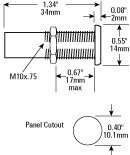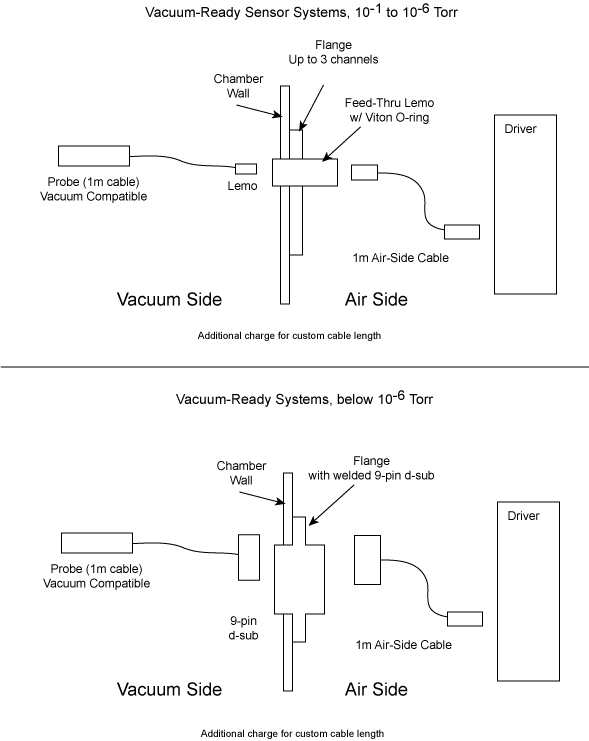TECHNOTE LT02-0021
Copyright © 2007 Lion Precision. www.lionprecision.com
Summary
This TechNote describes considerations for using eddy-current sensors in vacuum applications including:
- Outgassing
- Feed-Thru Connectors
- Low-Pressure Arcing
- Probe Generated Heat
- Typical Configurations
Capacitive Sensors in Vacuum
The problem with outgassing.
Any substance subjected to high-vacuum has the potential to release trapped gasses. These gasses can cause oxidation or contamination of surfaces in the vacuum environment. Depending on the application, outgassing may cause significant damage to the process or equipment. High-vacuum probe materials and processes are designed to minimize or eliminate outgassing.
Probe construction materials that minimize outgassing
The primary materials in probe construction are the metal body, epoxy, PEEK, conductors, and cabling. Vacuum compatible probes are constructed of 303 stainless steel. The epoxy in the probes has been specifically tested for vacuum applications requiring low outgassing. Probe cabling uses a PTFE jacket which is highly stable and produces very little outgassing. Conductors within the cable and probe are silver-plated, oxygen-free copper (OFC).
Optional bakeout before shipment
All probes are thoroughly cleaned and sealed in plastic bags before shipment. Optionally, vacuum compatible probes can be subjected to a “bakeout.” This processes bakes probes at 80°C for several hours in a slight vacuum. During the process, trapped moisture and gasses are removed from the probes and hydrocarbons are driven from the surfaces. The probes are then specially packaged to minimize contamination.
Feed-thru connectors (couplers)
Connection through the wall of the vacuum chamber is accomplished with vacuum compatible couplers or feed-thrus. Vacuum compatible probes have short cables with small, 5-pin Lemo connectors which connect to the vacuum side of a Lemo sealed coupler (figure 1). An extension type cable connects the outside of the coupler to the probe driver. These couplers are useful to 10-6 Torr (130 µPa) and have a specified leakage rate of 10-6 mbar liters/second.
For higher vacuums, probe and driver cables are fitted with 9-pin Sub D type connectors for mating with a Ceramaseal, ceramic filled coupler. While this withstands greater vacuum, the mounting is more complicated and the Sub D connectors do not provide as much cable strain relief as the Lemo connectors.

Lemo vacuum-compatible coupler
Low-voltage arcing
Paschen’s Law relates to the voltage at which gas breaks down (ionizes) and arcing occurs between two conductors. The law basically says that the breakdown characteristics of a gap are a function of the product of the gas pressure and the gap distance. The relationship is not linear.
This means that for a given gap between conductors, arcing will occur at lower voltages as the pressure decreases. At very low pressures the curve reaches a minimum and begins to increase again. That minimum point is about 300V for air. Argon goes as low as 150V. This minimum point occurs around 5 Torr (650Pa), dependent on conductor material and type of gas.
Lion Precision probes have a gap of about 1mm between the grounded body and the active conductor. The maximum potential between these conductors is less than 100V.
Standard Lion Precision probes don’t exceed the minimum voltage of Paschen curves and will not arc as pressure is reduced through the minimum point on the curve.
Probe generated heat
Eddy-current probe power consumption is dependent on the calibration. Typical power consumption ranges from 50µW to 3mW.
Configuration

